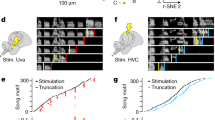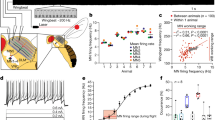Abstract
LOCUST flight has been intensively studied by behavioural physiologists. The basic flight rhythm seems to be generated within the thoracic ganglia1, although its timing is modified from wing beat to wing beat by phasic input from the wing sense organs2. In this way, the basic motor score is possibly tuned to operate at the resonant, most energetically efficient frequency of the individual insect, and adjusted to accomodate changes in wing movements caused by variations of the external air current. Sensory influences on the flight motor neurones do not only originate at the wings. Weis-Fogh has demonstrated that stimulation of the wind-sensitive head hairs causes tonic excitation of these motor neurones3. Here, we have recorded in the locust during flight, the activity of two of the interneurones that convey wind information from the head hair afferents to the thoracic ganglia. These interneurones, the tritocerebral commissural giants (TCG)4,5, receive their afferent wind hair input in the brain and make excitatory connections with flight motor neurones in the thoracic ganglia6. We show that these cells are rhythmically active during flight, synchronous with the wing beat, as a result of periodic stimulation of the head hairs. It is therefore possible that the wind-hair sensory system has a phasic influence on the flight motor as well as the already clearly established tonic influence.
This is a preview of subscription content, access via your institution
Access options
Subscribe to this journal
Receive 51 print issues and online access
$199.00 per year
only $3.90 per issue
Buy this article
- Purchase on Springer Link
- Instant access to full article PDF
Prices may be subject to local taxes which are calculated during checkout
Similar content being viewed by others
References
Wilson, D. M. J. exp. Biol. 38, 471–490 (1961).
Wendler, G. J. comp. Physiol. 88, 173–200 (1974).
Weis-Fogh, T. Nature 164, 873–874 (1949).
Bacon, J. thesis, Univ. Manchester (1977).
Bacon, J. & Tyrer, M. J. comp. Physiol. 126, 317–325 (1978).
Bacon, J. & Tyrer, M. Naturwissenschaften 66, 116–117 (1979).
Waldron, I. Z. vergl. Physiol. 57, 331–347 (1968).
Author information
Authors and Affiliations
Rights and permissions
About this article
Cite this article
BACON, J., MÖHL, B. Activity of an identified wind interneurone in a flying locust. Nature 278, 638–640 (1979). https://doi.org/10.1038/278638a0
Received:
Accepted:
Published:
Issue Date:
DOI: https://doi.org/10.1038/278638a0
This article is cited by
-
Central projections from Johnston’s organ in the locust: Axogenesis and brain neuroarchitecture
Development Genes and Evolution (2023)
-
Ontogeny and development of the tritocerebral commissure giant (TCG): an identified neuron in the brain of the grasshopper Schistocerca gregaria
Development Genes and Evolution (2018)
-
Mechanisms of flight steering in locusts
Experientia (1988)
-
The effect of forewing depressor activity on wing movement during locust flight
Biological Cybernetics (1988)
-
The tritocerebral commissure ?dwarf? (TCD): a major GABA-immunoreactive descending interneuron in the locust
Journal of Comparative Physiology A (1988)
Comments
By submitting a comment you agree to abide by our Terms and Community Guidelines. If you find something abusive or that does not comply with our terms or guidelines please flag it as inappropriate.



